This blog post is slightly different from the usual type of posts which I publish in that whilst it takes place within superb walking territory it is more related to the trip itself than any walks, and I have no doubt that the title of the blog post will give a little indication as to its location and context. Whilst I do enjoy writing this blog, and I do very much enjoy reading blogs of others which relate to walking and the Great Outdoors, I must admit to not being greatly enamoured with general travel blog offerings. Maybe it’s just me, but the way that the majority of travel bloggers come across appears that they are primarily bragging about being in exotic locations in either the far east or south America; but, hey, it certainly beats working for a living like most of us have to. As a matter of fact, and do feel free to call me a grumpy bugger, I have deleted a few travel bloggers from my Twitter account as they just have a tendency to get right up my nose with the sanctimonious “look where I am” showing off type of photos. I know this sounds like I’m whining, and possibly comes across as being quite hypocritical too, and I suppose it is, but let me reassure you that it is nothing to do with envy, but more to do with a dislike of the one-upmanship stance that seems so prevalent today – so there you have it, now I’ve got that off my chest I can carry on with what I had to write and show off about.
There is a slight back story to this blog post in that a number of weeks ago Mrs Muddy Boots was doing some online shopping and almost bought some more Harris Tweed for soft furnishing use at home. As a throwaway comment I said words to the effect of “why buy online when we can go and visit the place where it is made“. This generalised statement led to an intense week of precision planning in order to piece together a road trip up to the Isle of Harris, to the source of the Harris Tweed, if you will. Call me anal, but I even put a spreadsheet together to help with the organisation of the task – *sigh* yes, it did include mileages, costs and times. In my view, travelling 461 miles just to collect some Harris Tweed seemed a little extravagant, so in my general role as Chief Entertainments Officer for Mrs Muddy Boots, I decided to increase the remit of the road trip to encompass a number of distilleries as I knew that Mrs Muddy Boots would not turn her nose up at the prospect of having a wee dram or two.
Saturday 1st October – Day One – Home to Islay 345 miles
The start of this road trip involved getting out of bed at 4am, which was made more difficult for me by the fact that I didn’t fall asleep until about 1:30am on the Friday. It wasn’t quite the kid at Christmas, excitement type of thing but I do seem to struggle with falling off to sleep when I know that I have to be up especially early. Anyway 4am it was; I was up and dressed, albeit very bleary eyed and the car got loaded with the relevant bags and we were off north up the M6 by 5 o’clock. The reason for the early start was to get to the ferry terminal at Kennacraig in order to embark on the CalMac car ferry to Port Askaig, on Islay. We stopped at the Tebay services and changed drivers. Mrs Muddy Boots took over whilst I wound the passenger seat back and had a snooze to try and catch up on the sleep that I had missed on the night before. Before long we were pulling into the services again after Beattock and we both found refreshment from a McDonald’s sausage McMuffin and a strong cup of Coffee. Feeling rejuvenated by the refreshments and the snooze, I jumped back in the driving seat and we continued up some superb driving roads north of Glasgow, passing Loch Fyne (yes, the same one as the well known oysters come from) and some very grand scenery to Kennacraig where the ferry terminal is situated for the boat over to Islay. The scenery we passed was just a foretaste of what was to come.
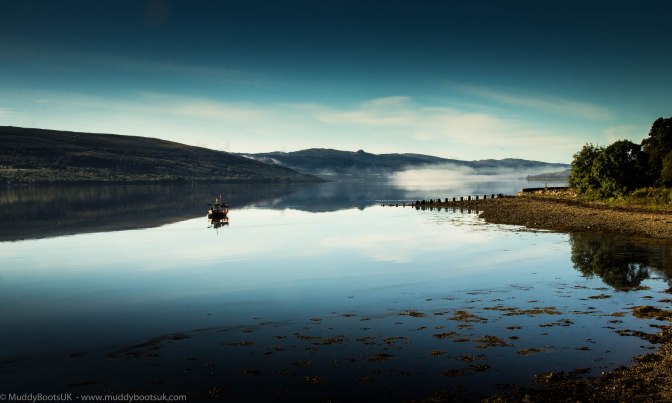
I was quite concerned about is getting there on time as we have ‘previous form’ for missing this particular boat. Around 20 years ago we came up this way and got to the ferry terminal just as the ferry was pulling out, and as a consequence we never got over to Islay; it was with very deep dismay that I had to cancel the accommodation on Islay and find somewhere else for the night. I needn’t have worried this time though, as the roads were quiet at this time of the morning, and it being Saturday too with no rush hour traffic to slow us down. Additionally, comfort was given from a SatNav display as you can see how your progress is from your estimated time of arrival which is indicated on the satnav screen and you can then adjust your driving tempo accordingly.
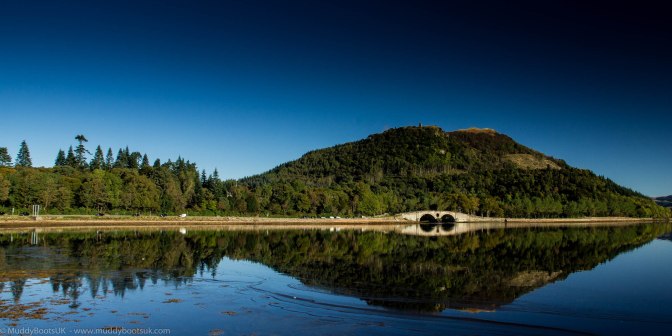
Needless to say we got there much earlier than anticipated which I didn’t mind at all, so we sat around the ferry terminal looking out to sea, just waiting and enjoying the very warm autumn sunshine.
As we sat at the quayside a slow but steady stream of assorted vehicles arrived. There were builders vans, camper vans, pickup trucks, caravans, trucks, cars, motorbikes and cycles. All were orderly parked up in the relevant traffic lane as directed by the chap on the gate with the high viz vest. It seem quite relaxed and peaceful, the loch was lapping on the shore, birdsong was filling the air (well apart from the screaming little kid from the car in front) and there was very little that would indicate the frenzied activity that was to start when the ferry docked at the port.
At about 12:15 the ferry chugged into view in the distance on West Loch Tarbert and slowly made its way along the loch to the Kennacraig terminal with a low and menacing rumble of large engines doing some heavy work. Quite suddenly as the boat approached the jetty, a large number of men sporting hi-viz vests and hard hats appeared from nowhere and proceed to undertake various tasks relating to the securing of the boat. An alarm went off somewhere on board and the bow doors slowly opened and in no time at all cars and trucks were being rapidly driven off and disappeared up the terminal approach road in a cloud of dust and exhaust fumes. It was the nautical equivalent of the F1 starting grid.
Shortly after this the various lines of vehicles which surrounded us were starting their engines and getting ready to board. The useless couple in front of us with the screaming kid seem quite surprised by this change in circumstance and as our line of vehicles started to move they decided they’d better get a hold of their offspring, who was still outside running about (and screaming) and fasten it into the child seat, thus causing us and everyone behind us to wait whilst they readied themselves. Surely they would have known at some point they would have to drive their car onto this big metal thing, the size of an apartment block, floating on the water, or maybe they hadn’t noticed its arrival as they were so engrossed in a Tupperware box of sandwiches they had packed for their journey. Perhaps they were just out for an early morning family picnic by the loch and inadvertantly got mixed up with ferry traffic. Useless people! We hadn’t seen the last of this pair of clowns as most of the ferry was to bump into them later as they let their noisy offspring run around the boat during the crossing whilst it shrieked like a maniac and bounced off the furniture. They looked useless too, and as my mother would put it, they had the appearance of a pair of “wet lettuces”. I am convinced humanity has reached its point of ‘peak intelligence’ and now seems to be on a downward slope of stupidity, a little like a bell curve type of graph. Each generation getting a little more stupid than the last. You can add ‘cynical’ to the list of names that are acceptable to call me.
As we were on the MV Finlaggan for 2 1/2 hours we decided to get something to eat at the “Mariners” restaurant on board. I must admit that the food was good and that I was also very surprised at finding this out; it wasn’t what I had expected. It was your basic “pub food” type fayre such as pie and chips, beef burger and chips etc, and it was very well executed and had a Scottish twist to every dish. The Beef Burger was Aberdeen Angus, the Steak and Ale pie had Scottish ale in it (a pint of heavy?) the fish was Scottish salmon, the Mars Bar was deep fried – no, only kidding with that one, but you get the feel for it. After finishing our lunch we went and stood outside on the observation deck as the weather was fine and we had a very clear view across the Sound of Jura and fantastic views of both Islay and Jura which were rapidly approaching, with the Paps of Jura being very prominent.

We sailed up the Sound of Islay, the narrow strip of water which separates Islay from Jura and docked at Port Askaig which appeared to be little more than a collection of small houses clinging onto a cliff face and a winding tarmac access road leading from the ferry terminal to the main road crossing the island. The ferry arrived at 2:55pm as scheduled and we had soon got back into our car and left the boat behind by joining the nautical F1 starting grid we witnessed previously at Kennacraig. There was one exception to this quick getaway as there were some cars still waiting on the boat due to a useless family with a screaming child being surprised by having to get back into their vehicle and drive away back onto Terra Firma. I really hoped we wouldn’t encounter this pair (and progeny) again. We made our way up the winding road that leads from Port Askaig to the A846 road that runs east-west across the island and kept pace with the tyre smoke and high velocity – I felt like Stirling Moss!
We got to the top of the cliffs that form the eastern shore of Islay and started driving through an undulating, agricultural landscape dotted with small bungalows with corrugated iron roofs. Mrs Muddy Boots said it reminded her of Ireland, and I had to agree. We took our first turning on the right which led us along a single track tarmac road leading to the Caol Ila distillery. This distillery was the first one of the trip and it was one which I had not really come across before. Due to the time the ferry got in we had missed the tour of the distillery so we had to just make do with buying a bottle from the distillery shop and trying a few wee drams as tasters prior to our purchase which was no bad thing.
The distillery has had a bit of a chequered past. It was started in 1846 by Hector Henderson and changed hands in 1854. In the 1880’s over 147,000 gallons of whisky were being produced annually. Through the 1920’s and 1930’s it changed ownership a number of times, and production was halted during the second world war due to the restrictions on the use of barley for distilling – (see the film “Whisky Galore“). Production resumed in 1945 and continued until 1972 when the whole distillery plant was demolished and rebuilt with production resuming in 1974. Today it is owned by Diageo. As well as producing its own single malts it is used heavily in the production of Johnnie Walker and Black Label blended whiskies. The single malts tend to score high ratings in spirit competitions and also on online forums.
We tried three different “expressions” as they are known and plumped for Caol Ila “Moch”. This particular whisky is lighter in style than the standard 12-year-old and takes its name from the Gaelic for ‘dawn’ and makes for quite an easy drinking dram. The nose is creamy and lemony with a peaty punch and a dry finish. After having a quick mooch around the outside of the distillery we jumped back into the car and made our way back to the A846. We drove further along the road in the direction of Bridgend for about a mile and then took another right hand turn along an apparent farm track which led us to the Bunnahabhain distillery (pronounced Boon-a-havn).
Bunnahabhain Distillery was built in 1880/1881 by a partnership which was incorporated in 1882 as the Islay Distillery Co., and later amalgamated with Wm. Grant & Co., (Glenrothes – Glenlivet) to form Highland Distillers, the present owners are Distell, as South African brewing conglomerate. Bunnahabhain is one of the milder Islay whiskies available and in its taste varies greatly from other fine spirits to be found on the island. The water rises through limestone and is transported by pipeline to the distillery, so it doesn’t pick up any peat on the way. Common bottlings are 12, 18 and 25 years old.
The drive towards Bunnahabhain from Port Askaig, passing over the long and winding road is great, and the location of the distillery is stunning. The road offers wonderful views of Jura, the Sound of Islay and the Rhuvaal Lighthouse on the most northern tip of Islay. The distillery is situated on the coast at Bunnahabhainn Bay and is quite large with a number of outbuildings which look to have seen better days. There is also a number of disused houses that form Bunnahabhain village and used to house the workers, which would today make fantastic holiday cottages. Again, we missed the tour at this distillery as it had been fully booked for a group visit which was my fault as I delayed in responding to the email from them. We tested a couple of wee drams and then decided to go for a fantastic 12-year-old which I have to say is as good as I expected. This particular “expression” seems to get a very high rating on whisky websites. An interesting fact is that the 12 yr old is a favourite dram of many Ilich (people from Islay).
After stowing the booty from the shop into the car we then made our way back down the winding road to the A846 and rapidly made our way to book into the Bridgend Hotel in which we were staying up for two nights. The Hotel had some good reviews online, but one has to bear in mind the 80:20 rule when reading websites such as Trip Advisor and go for a generalized overview and read between the reviews. Opinions are like arseholes, and everybody has one, although the cynic in me says that those who leave bad reviews are just doing it to try and get money off or something for nothing from the owners of the establishment they are reviewing. The role of the critic is too easy sometimes.

We parked at the front of the hotel which was a mid-19th century stone built and gabled Victorian property on the A847 north-south road which runs through the island. The interior of the Hotel was well decorated and well furnished with some fantastic stag antler chandeliers on the staircase, and some very plush tartan carpets throughout the place which gave a contemporary feel. The reception was tucked away at the back on the ground floor and I ended up going into the bar at first to check in which is good mistake to make. We soon checked in and took our bags up to our room which was situated at the front of the Hotel overlooking the local community bowling green and well tended gardens to the side of the hotel. The room was well furnished, very clean and well laid out with an ensuite bathroom and shower. We had a table booked at Yan’s Kitchen down in Port Charlotte at 8pm. I took this time to lie on the bed for a short while and have a nap whilst Mrs Muddy Boots watched Strictly Come Dancing, and I found that listening to it was the perfect antidote to insomnia. After a short and refreshing snooze I decided to get ready to go out for the evening. Let me say this without resorting to bold text, or capital letters, that the shower in this en-suite is the best I have ever been in. Rather like being showered with a hot Karcher pressure washer. You didn’t need soap, any dirt was blasted clean off! I put my head under it and it was like having an Indian head massage, absolutely marvellous! I would go back all that way just to stand under this shower again.
As our deadline with Yan’s Kitchen approached, we proceeded to make our way down the A847 in the direction of Port Charlotte and along the road which runs on the north bank of Loch Indaal. We passed the Bruichladdich distillery and entered the small village of Port Charlotte. Port Charlotte was named after Lord Frederick Campbell’s wife, and it was set up mainly to provide housing facilities for the now closed Lochindaal Distillery workforce. Parts of the former distillery buildings are now in use as Youth Hostel and Wildlife Centre. The remaining warehouses are currently owned and used by Bruichladdich distillery to mature their Port Charlotte heavily peated spirit, named in tribute to the village and original distillery. No plans have been formally announced to reopen Port Charlotte Distillery to date. We actually drove past Yan’s Kitchen and had to turn around in the village and come back. It is situated next to a large car park so access is very good. I had got the details of this place off TripAdvisor and emailed through a booking and had a very courteous and quick response. The building is a single storey structure next to a beach facing Loch Indaal and on the outer edge of Port Charlotte. We went in and were warmly greeted by the staff, and were shown straight to our table. The sky outside was clear and the temperature was dropping, so we were situated to the side of the log burning stove and had a window seat – not that we could see anything much as it was dark, but I did ask for one on my email. There was a regular menu and a specials blackboard mounted to the wall, which unusually had a small section dedicated to tapas dishes. We started by ordering a plate of 6 oysters, however they only had three left, so we had these between us. We then moved onto our starters of clam chowder and then progressed to Yan’s Legendary Seafood Platter each. The food was fantastic, simple but very well done and the clam chowder was just divine.
The seafood platter was great, although there much cussing as we tried to get into what appeared to be armour plated crab claws, and much crab shell went whizzing through the air as we struggled in vain with the crab crackers to get the succulent meat contained within. We very nearly had to apologise to a couple on an adjacent table as they were narrowly missed by some flying crustacean. In mitigation, it doesn’t help much when your fingers are covered with garlic butter. The platter consisted of scallops, lobster, crab, salad and fresh chips. We had to pass on the pudding as we were getting to the point of needing a wheelbarrow each to get us back out to the car. We paid the bill and waddled out and said that we would certainly come back here again.
The sky was cloudless and was patterned with millions of stars and the background sound of Loch Indaal ebbing on the nearby beach gave a magical feel to the night. Prior to heading back to The Bridgend Hotel we went back across the island and up the road towards the Bunnahabhain distillery. We stopped the car at a prominent point overlooking the Sound of Islay and I took the opportunity of getting my camera out to take some night time shots without any added light pollution. We then headed back to the Bridgend Hotel for a much needed nights rest after a long and busy day.
Sunday 2nd October – Day Two – The Distilleries Dash
I awoke well refreshed at about 6:40am. I looked out of the window and it was just coming light, the sky was clear and the air was very still. As breakfast at the hotel wasn’t served until 8:30 I decided to get out with my camera for an hour or so and see what I could get in the early morning light. I quickly dressed, quietly left the building and got into the car. Not knowing the area I decided to drive down to Bowmore, which was about 3 miles along the A846 road on the southern side of Loch Indaal. The Bowmore distillery is located in this small town, which is set around a small harbour and I thought I may get lucky with the light, or see something that would make a good composition.
I pulled up on The Square in the centre of Bowmore and parked in one of the many spaces available. I got out of the car, collected my tripod and camera bag from the boot, locked the car and walked down to the harbour. I stood for a while contemplating the scene and assessing the suitability for any decent photographs and I watched a middle-aged lady walking up and down the harbour wall. As she passed behind me she let out a cheery “Good morning, lovely morning isn’t it?” to which I nodded my acknowledgement although not as cheery as she was in the morning.
I proceeded to take a number of photographs of the small harbour and the boats, and even walked along to the end of the harbour wall where I passed a white transit van which was parked up and had its side door slid open as if loading the adjacent boat but there was nobody around – complete silence. It may have been left open like this all night which I found a little strange. Where I live you have to be careful closing your house windows of an evening as you can end up trapping some scrotes fingers as they try to get in.
I walked over to the opposite side of the harbour onto a small pebbly beach and took some photographs of the Bowmore distillery which overlooks the loch at this point. I then had a short wander around the centre of the village which was very quiet at this time of the morning before deciding to make my way back to the Hotel for some breakfast. When we went down for breakfast we noted a large number of foreign visitors staying at the hotel. There were Dutch, Spanish, German, American and Japanese people sat at various tables in the breakfast room. I didn’t realise the draw of Islay was so widespread. The breakfast menu is quite extensive and I ended up going for the Full Monty, or Full Scottish Breakfast as it is formally known, which is the usual scenario for me in these situations. After a short time and finishing the last of the toast and marmalade and draining the pot of tea we decided we should make our way out for the day.
The first place to visit was the Bruichladdich distillery, and we arrived there at 9:30am which was a little too early to be honest. We drove into the distillery yard and everything was closed and quiet. We noticed a small sign on the shop door stating that the shop was open from midday until three so we decided we would leave and come back later if we could. The next distillery in the vicinity was situated at Bowmore, so we headed back along the loch, past the hotel and down to the small village. It was a short drive and we were there within 10 minutes. We parked up on the main road and walked up to the distillery entrance and were surprised to learn that it didn’t open on a Sunday – we weren’t the only ones disappointed by this, as quite a small crowd had appeared expecting entry. The distillery itself was in operation and the gates were open and you could wander around at will; I grabbed a few photographs and decided that we would come back later to try and buy a bottle of one of their products.
So far no success in the distilleries we had visited, but it was early on a Sunday morning. We then decided to head south on Islay and try our luck with the ones down on that coast. We travelled down the A846, past the airport and headed towards Port Ellen which is the largest of the towns on Islay. When we got Port Ellen we continued along the road through the town centre, past the harbour and took a sharp left turn and travelled along the south coast of the island until we got to the the Laphroaig distillery which was situated on Loch Laphroaig.
The Laphroaig distillery was established in 1815 by Donald and Alexander Johnston. The Johnstons who founded Laphroaig were from the Clan Donald and are likely to be from the MacIain of Ardnamurchan branch of the clan. The family anglicised their name to Johnston. The last member of the Johnston family to run the distillery was Ian Hunter, a nephew of Sandy Johnston, who died childless in 1954 and left the distillery to one of his managers, Bessie Williamson.
The distillery was sold to Long John International in the 1960s, and subsequently became part of Allied Domecq, which was in turn acquired by Fortune Brands in 2005, as one of the brands divested by Pernod Ricard in order to obtain regulatory approval for its takeover of Allied Domecq. Fortune Brands then split up its business product lines in 2011, forming its spirits business into Beam Inc. Beam was then purchased by Suntory Holdings in April 2014.
Laphroaig has been the only whisky to carry the Royal Warrant of the Prince of Wales, which was awarded in person during a visit to the distillery in 1994. The 15-year-old was reportedly the prince’s favourite Scotch whisky.
The distillery was open when we got there and the car park was quite busy. We entered the visitor centre and shop and enquired about the tour, however the lady at the counter said the first tour of the day had got under way and was fully booked. We didn’t really have the time to wait around until the next one though, so were content to try a few small samples in the shop to assist us with our purchase. We came away with a couple of different bottles to try: Laphroaig “Select” and Laphroaig “Triple Wood”, in addition to the land rental payment of a small 10-year-old. For the Laphroaig “Select”, the distillery has taken whisky from a number of different types of cask, including Oloroso Sherry butts, white American oak, Pedro Ximenez seasoned barrels, Quarter casks and first fill bourbon casks. Whilst still having the peatiness of a Laphroaig, it is a more laid-back addition to the Laphroaig range of single malts. The “Triple Wood” was originally launched for the duty free market, but you can now get it in various outlets. They mature this in bourbon barrels first, before transferring into quarter casks for a time, followed by a third maturation in Oloroso sherry European oak butts. Oodles of peat smoke and sweetness.
Whilst we were at the Laphroaig distillery the lady in the shop explained that there once was a dispute on the land where they source the water, and this dispute was caused by a neighbouring distillery wanting access to the same water source. In order to prevent others taking possession of the water on the land in future they are gifting a lifetime lease on a square foot of Islay to their visitors who sign up as “Friends of Laphroaig“. Laphroaig will in turn rent this square foot of land from you with payment being a small bottle of Laphroaig per year, which you claim in person, from the distillery when you visit. The upshot of this is that should any person, in the future try and get access to the same water source they would, via their legal representatives, have to contact everybody who owns a square foot of land in order to try and get their permission and this would delay the resolution of any dispute by a large number of years and cost a substantial sum of money to see through to its ultimate conclusion. I have a certificate on my study wall saying I own a little piece of Islay!
We drove out from the distillery back onto the main road and headed towards the next stop travelling east which was Lagavulin. This is situated directly on the main road itself. The distillery of Lagavulin officially dates from 1816, when John Jonston and Archibald Campbell constructed two distilleries on the site. One of them became Lagavulin, taking over the other—which one is not exactly known. Records show illicit distillation in at least ten illegal distilleries on the site as far back as 1742. In the 19th century, several legal battles ensued with their neighbour Laphroaig, brought about after the distiller at Lagavulin, Sir Peter Mackie, leased the Laphroaig distillery. It is said that Mackie attempted to copy Laphroaig’s style. Since the water and peat at Lagavulin’s premises was different from that at Laphroaig’s, the result was different.
We pulled into the small car park and were the only ones there which led us to think that perhaps it was closed. We followed the signs, and barrels, for the shop and visitor centre and entered through the small side door. Lo! and behold it was open – although they weren’t undertaking any tours. We browsed the selection of whiskies on offer, and also the range of branded quality clothing – Lagavulin polo shirt? We chose a four dram sample and were offered seats in the “sample room” where we undertook a tasting of the four different drams along with a selection of specialist chocolates that they also offer; one type of chocolate to accompany each whisky. The sample room is quite surprising as it was very tastefully decorated and furnished in a very traditional style similar to a Gentleman’s Club. As we sat there and the lady explained the difference between the four whiskies and a couple of German lads also took up residence in the corner of the sample room and undertook their own tasting session.
As I was driving I only had a wee nip and Mrs Muddy Boots had the greater amount to herself. We managed to work out which was our favourite of these different Lagavulin expressions and wandered back to the shop at the front of the building and proceeded to purchase a bottle of 16-year-old “Distillers Edition” whisky. By far the most popular of the “Distillers Edition” series, this double-matured Lagavulin has had a finishing period in sweet, sticky Pedro Ximénez sherry casks. It is, apparently, ‘a whisky that never disappoints’ and I can truly state that it didn’t. We really enjoyed the visit at Lagavulin and the visitor centre was very well-designed and comfortable, and the staff were very welcoming too. We climbed back into the car and made our way further along the main road until we got to Ardbeg which was the last distillery along this stretch of the island. As we pulled up at Ardbeg it became apparent that the owners, Louis Vuitton Moet Hennessey, had spent a large amount of cash renovating and rejuvenating the buildings and a fantastic job of it they had done too.
Ardbeg Distillery is one of the three “Kildalton Distilleries” and can be found on Islay’s south coast. The name Ardbeg comes from the local village where the distillery is situated and is derived from the Scottish Gaelic: Àrd Beag, meaning Small Headland. It distills one of the peatiest whiskies on the island.
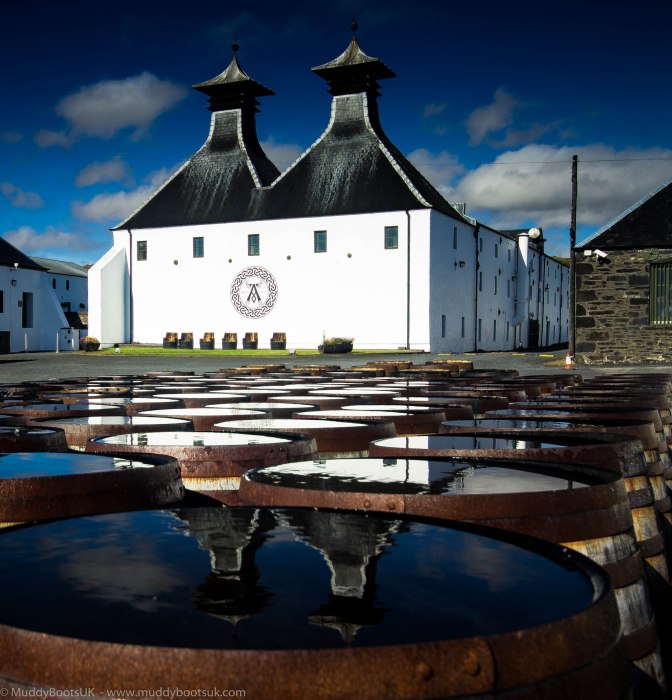
Ardbeg distillery was established in 1815 and operated as a private concern until January 1977 when it was taken over by Hiram Walker who sadly demolished the best of the maturing warehouses. It was later sold to Allied Distillers, who ‘mothballed’ the distillery in 1981 and Ardbeg remained silent until 1989. During those years the buildings were allowed to fall into disrepair. Ardbeg Distillery was bought and reopened in 1997 by Glenmorangie Plc, and is now one of the fastest growing Islay Single Malt Whiskies. Glenmorangie invested heavily in refurbishing the buildings and plant. Glenmorangie Plc. is owned by the French company, LVMH (Louis Vuitton Moët Hennessy). At Ardbeg they produce around 160 barrels a week. With each barrel they fill 250 bottles and so they produce a staggering 40.000 bottles of whisky each week. For that they work continuously, 24 hours a day, 6 1/2 days a week with 6 persons in the distillery and 3 in the warehouse. At the moment of writing the warehouses were completely full. Because of that the maturing takes place in other warehouses in Edinburgh. Ardbeg distillery get their Barley from Port Ellen Maltings. To maintain Ardbeg’s very distinctive character, the specification of malt used in the production of Ardbeg requires it to be at a minimum level of 50 p.p.m. phenol, which comes from drying the malt over peat fires, and so 60 tons of very peaty barley are consumed each each week.
Visitors to Ardbeg will find an added bonus; the very fine “Old Kiln Café”, where excellent lunches can be enjoyed including a taste of the end product. We didn’t eat, but the menu was excellent and the Cafe very busy. We came away with a bottle of “Uigeadail”. Uigeadail derives from the Scotch Gaelic for ‘Dark and Mysterious Place’ and is named for the loch from whence Ardbeg draws its waters which is high in the Islay hills above Ardbeg. It is a marriage of Ardbeg from bourbon barrels and sherry butts which gives a sweet and smoky finish and is very well regarded.
As lunchtime was getting close we made our way back north to Bowmore so we could have lunch at The Harbour Inn at Bowmore. This place had some good write-ups on Tripadvisor, and again, we didn’t really know what to expect when we got there. The drive north across the island took only 20 minutes and the road leading from north to south is arrow straight; it could have almost been built by the Romans, although they never got this far north. We parked up again in the centre of Bowmore, on the square opposite The Harbour Inn and entered the front door. What a surprise! This was certainly not what we expected at all. It was very tastefully decorated and quite contemporary in styling. We requested a table for two in the restaurant and were very quickly seated by the window. The view overlooking Loch Indaal was exceptional, with the Paps of Jura being visible on the far horizon.
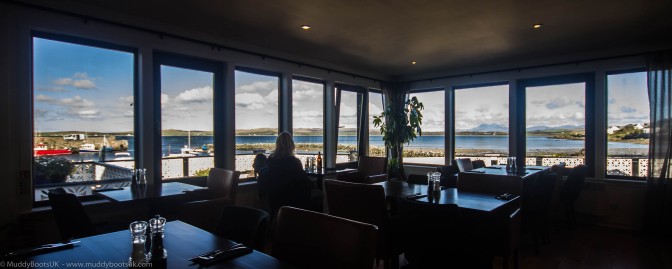
There were a number of tables occupied although it wasn’t overly busy. We ordered a bottle of wine and a bottle of sparkling mineral water and proceeded to peruse the menu. We decided not to go for anything very heavy due to the large breakfast we had already had and the forthcoming, substantial evening meal back at the Bridgend hotel. We ended up starting with half a dozen oysters which were accompanied with Tabasco and shallots with red wine vinegar. Mrs Muddy Boots followed this with the “Seafood Board” comprising smoked salmon, prawns, capers, guacamole, shallots, pickled samphire, farm bread and salad. I had the seafood linguine made with fresh fish, shellfish and a cream sauce with lemon zest. Both dishes were very good, and very well presented too.
Whilst eating our lunch we decided that we would revisit the Bruichladdich distillery and then take a chance on the Kilchoman distillery as it was over there somewhere (we had passed a signpost for it earlier on in the day). We finished our delicious lunch, paid the bill and departed the Inn. However, whilst we were in Bowmore we called at the Islay Whisky Shop, which was a one minute walk around the corner from the Inn to see if they had a bottle of Bowmore on sale as the distillery shop was closed. Wow! What a selection! There was a wall full of whisky from floor to ceiling, and not just Islay ones. There was one bottle in there from the Port Ellen distillery which has now closed, and this was priced at £2,500! How much is that per snifter? What I also found amusing is that this shop is also shown as being a “Spar” supermarket, with the sign above the front entrance door – I can tell you this with certainty; the “Spar” supermarkets near to where I live do not stock whisky at two and a half thousand pounds a bottle. After spending some time perusing the vast selection we came away with a superb Bowmore “Darkest” 15-year-old, which according to the box has flavours of “rich raisins and gentle smoke lead the way to a delicious chocolatey centre”. As is common with a number of whiskies now it is sherry cask finished, and more particularly uses Oloroso sherry casks and very good it is too – but can’t taste the chocolatey notes.
We left Bowmore behind and drove back along the A847, past the Bridgend Hotel (again) and along the north shore of Loch Indaal until we reached Bruichladdich again. Bruichladdich was built in 1881 by the Harvey brothers—William (32), John (31) and Robert (23). The Harveys were a dynastic whisky family that had owned two Glasgow distilleries since 1770. Using an inheritance, the three brothers combined their talents to build a third distillery, Bruichladdich, designed by John, engineered by Robert, and financed by William and other family members. At the time, the distillery was a state-of-the-art design unlike Islay’s older distilleries, which had developed from old farm buildings. It was built from stone from the sea shore and has a very efficient layout, built around a large, spacious courtyard. The uniquely tall and narrow-necked stills were chosen to produce a very pure and original spirit, the opposite of the styles produced by the older farm distilleries. Bruichladdich was run by William Harvey, after a quarrel with his brothers before the distillery was even completed, until a fire in 1934 and his death in 1936. Over the next forty years it subsequently changed owners several times as a result of corporate take-overs and rationalisation of the industry, narrowly avoiding closure until 1994, when it was shut down as being ‘surplus to requirements’.
The distillery was subsequently purchased by a group of private investors led by Mark Reynier of Murray McDavid on 19 December 2000. Jim McEwan, who had worked at Bowmore Distillery since the age of 15, was hired as master distiller and production director. Between January and May 2001 the whole distillery was dismantled and reassembled, with the original Victorian décor and equipment retained. Having escaped modernisation, most of the original Harvey machinery is still in use today. No computers are used in production with all processes controlled by a pool of skilled artisans who pass on information orally and largely measure progress using dipsticks and simple flotation devices. On 23 July 2012, it was announced that Rémy Cointreau reached an agreement with Bruichladdich to buy the distillery for a sum of £58m.
We went back into the distillery yard with a feeling of deja-vu and parked directly outside the ‘Laddie Shop’. We went in and were confronted with a huge array of whiskies for sale. We didn’t know where to start, so asked for some assistance from one of the the three young ladies who were running the shop. After trying a few drams of different expressions (there’s that word again) Mrs Muddy Boots asked for something a bit different and the way she said it was like asking for something ‘under the counter’. The young lady produced a bottle of Port Charlotte 2007 CC:01, which is a tribute to the exceptional, heavily peated spirit that was created in the village, at Loch Indaal distillery, until its closure in 1929. It doesn’t taste too peaty initially, but has a long finish with the smokiness coming through at the end. We relieved them of a bottle. Whilst we stood in the shop discussing the various drams, we noticed a clear bottle on the shelf behind the counter. It turns out that Bruichladdich now produce Islay’s first gin, called The Botanist and the marketing blurb states that there are 22 ‘botanicals’ in the gin with the majority being foraged on the island. We did have a taste of this too, and took a bottle away for further research.
We left left the distillery at Bruichladdich behind and drove eastwards along the main road heading back towards Bridgend. About a mile east of Bruichladdich we came across a sign pointing to the Kilchoman distillery (pronounced Kil-ho-man) and we took an abrupt left turn and headed a long a single track tarmac road passing through farmland for about 5 miles. this was a bit disconcerting as I was convinced we had missed it due to the type of road. After a period of doubt we came across another sign leading is up a gravel track to a collection of large industrial type buildings along with a traditionally built farm house, so we went up the drive. Kilchoman is known as Islay’s farm distillery and is relatively new. It began production in 2005 and was the first new distillery to be built on the island of Islay in 124 years. The farm also grows its own barley, which is malted at the distillery and Kilchoman is quite unique in that all parts of the process such as growing barley, malting, distilling, maturing and bottling are carried out on the island, whereas a number of the other distillers take their end product out in tankers to bottling plants on the mainland.
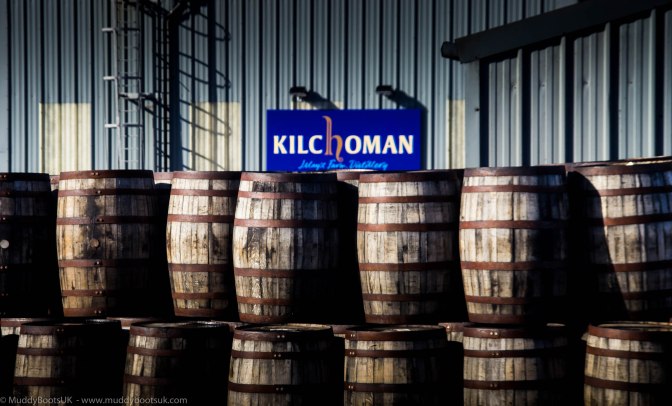
The number of cars in the visitor car park was surprising and the distillery shop was very busy when we entered, with the majority of people being international visitors. For such a young distillery there was quite a selection of products available and we need samples to help us decide what to get. We spoke to one of the staff members who sorted us out with a 3 dram sampling.
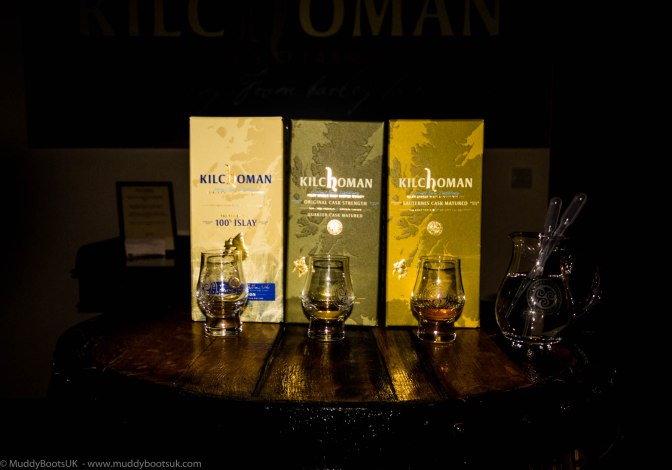
We considered the various samples and went for the Sauternes Cask release as it is a bit different. Spending more than five years in the casks from Chateau d’Yquem in Bordeaux, the whisky has takes on the influence associated with Sauternes casks while remaining balanced with maritime peaty smoke and sweet citrus. Only 6,000 bottles have been released at a strength of 50% abv, and it is quite more-ish.
Time was getting on and we left Kilchoman and made our way back to the A846 and headed towards the Islay Woollen Mill which we had learned about earlier on in the day whilst talking to the staff at Lagavulin. When we found it up a rutted track off the A846, tucked away in a valley next to the River Sorn at Redhouses. It is a small craft weaving place and has the appearance of one having travelled back in time a hundred years. Unfortunately it had just closed when we got there, but we did press our noses up against the glass to look at the products on sale in the shop and Mrs Muddy Boots got quite excited – this happens to her with soft furnishings and fabrics. We were disappointed to find it closed and sadly had to drive off ‘Tweedless’. I have since found out that the shop produces the tweed fabric for Huntsman, the well known (and very expensive) Savile Row tailors so I look forward to visiting again in the future.
It seemed a little early in the evening to go back to the hotel so we drove down to Singing Sands beach at Kilnaughton Bay to the west of Port Ellen and went for a stroll along the sands. We parked up on some grass next to the road and got out of the car and there was quite a stiff breeze blowing in off the sea, and a solitary kite surfer was making the most of this by showing his skills in the bay; he was travelling along at a fair lick too.
As we walked along the sands, I kept getting shots of the kite surfer as I had my long lens on, and over the time we walked from one end of the bay and we were making our way back the kitesurfer had also made his way back to shore. As we approached he was packing his stuff away and we ended up talking. He was Willi from Fraserburgh, and come over to try the beaches on Islay. We had seen him (or his car) earlier in the day at Ardbeg distillery, and he said he was just killing time there until the wind had got up to a sufficient speed for him to kitesurf at Laggan Bay. He asked me to forward him any decent shots, and I passed him my card. I did hear from him via Twitter, and sent him the best of the photos which I had taken. From Kilnaughton Bay we called at Laggan Bay as we were passing it on our way back to the hotel. We found it down a very rough and rutted track which was populated by hundreds of pheasants that kept running in front of the car, they were either suicidal or just very stupid. We parked in the dunes at Laggan Bay and walked a short distance to the beach. Along the way we passed a VW camper van that was parked overlooking the bay which was the drive of choice for the three surfer dudes getting changed inside, and judging from the number plate they had come all the way from the Czech republic too. We watched the sun setting over the Atlantic Ocean for some minutes before turning around in the encroaching dusk to walk back to the car and head back to the hotel.
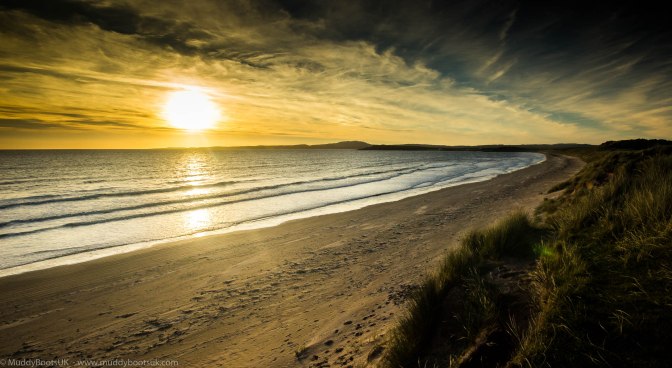
One thing that I found a little odd whilst driving around Islay was that many motorists gave you a small wave type of hand gesture as you approached them from the opposite direction when driving along the roads. The first few times it happened I thought the drivers had mistaken me for someone else with the same car, but pretty much everywhere we went to, drivers approaching on the opposite side of the road lifted their hand up from the top of the steering wheel in acknowledgement of you. I eventually asked one of the staff at the hotel who was brought up on Islay what was going on and she said it was known as “the Islay wave”, and came about many years ago when very few people on the island had motor vehicles, and those that did would greet other vehicle owners in this manner; very much as classic car owners do when encountering a similar vehicle to their own and this tradition was still carried on. It certainly made me feel like a local.
We reserved our table in the dining room and went up to our room to freshen up. We came back down after a short while and made our way to the bar prior to entering the dining room. I was served by a young chap at the bar, whose accent stood out quite clearly as being Lancastrian. I asked where he was from and he initially said Yorkshire, but then elaborated that despite being born in Yorkshire he had lived most of his life in Lancashire. I asked him to be more specific and he sort of rolled his eyes a bit and then named his street, which is actually 5 minutes from the village where I live! We got talking about some mutual acquaintances and how my village pub had changed since its recent refurbishment. Why does this sort of thing happen? It has happened to me in Crete too. It must be down to six degrees of separation and all that; quite spooky in a way.
We went into the Hotel restaurant and were pleasantly surprised by the menu. We both had starters and a main but declined the pudding due to feeling stuffed from lunch. I had a Cullen Skink starter and Mrs Muddy Boots went for the Langoustines, and both were really well carried out. I cannot remember what we had for mains, although it was delicious and accompanied by plenty of vegetables. We had an enjoyable bottle of red and soon took to our room for an early night after all the dashing around the island that day.
Monday 3rd October – Day Three – Northward Ho!
We were up early this morning as we had to be off for the ferry back to Kennacraig. This sailing went from Port Ellen and departed at 09:45am and we had to check in by 09:15. As we were about 25 minutes away we had to check out by 08:45am. One last shower under the ‘Karcher’ and our bags packed we went and checked out. We settled the bill and rapidly made our way to the CalMac terminal at Port Ellen. There were a number of cars already queuing and we joined them. I got out and had a walk around, not that there was much to see. The ferry wasn’t even to be seen. It gradually appeared on the horizon, and slowly approached taking a bit of a zig-zag type of path to avoid the various small rocky islets and hidden obstacles.
With surprising speed, the ferry quickly moored up, and the vehicles and passengers soon disembarked and we were being signalled to board. We parked the car up on the deck, left it and went up to the passenger lounge. For the majority of the journey we sat at the back of the boat and watched Islay slowly recede from our view. We were sad to be leaving, but excited about the prospect of further adventures. The news had warned about high winds and ferry cancellations, but this didn’t seem to be affecting this particular route, so we dismissed it.
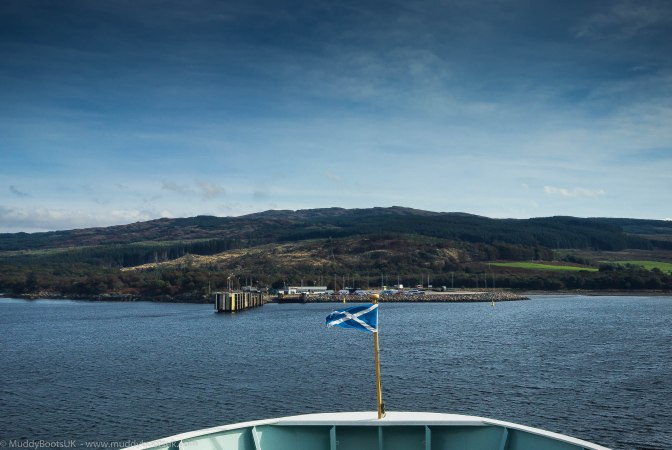
On the approach to Kennacraig I stood on the front observation deck and ended up chatting to Giancarlo who had a two day holiday on Islay with his pal from Glasgow. He had come over from Italy on Friday, stayed at his mates place and they had driven up to get the boat on Saturday morning, and he was now making his way back home. Giancarlo worked for Eurostar and had a month off work to use his holidays up, although the two days on Islay would have been had it been me. We were soon pulling into Kennacraig, and the announcement came over the PA system to make our way back to the vehicle deck. We went back to the car, got in and readied ourselves for the 142 mile drive up to Mallaig via Oban. We went up the A83 (the main which runs the length of the Mull of Kintyre) and left it at Lochgilphead, and took the A816 all the way to Oban. As we approached Lochgilphead I received a text message from CalMac ferries notifying us that our ferry from Uig on Skye the following evening had been cancelled due to the high winds experienced today. now, I consider myself a logical problem solver, but this had me beat! How can this happen, and what was I going to do about it? I certainly didn’t want to cancel our stay on the Isle of Harris, so I phoned Calmac. They swapped our cancelled ferry booking to one departing from Ullapool, which would drop us in Stornoway, and then I would then drive down through Lewis to Tarbert on Harris. A long way around, but the problem solved! Apart from this last minute re-jig the journey was uneventful and the roads were good. We arrived in Oban a little after midday, so we parked at the station and made our way around to the CalMac ferry terminal to search out the The Green Shack. Again, like most places on this trip I came across it on Tripadvisor and it has had a number of reviews in the national broadsheets so must be something special.
We arrived and it was packed, with people sat outside tucking into lobsters, mussels, crabs and various other seafood delicacies. The prices were ridiculously cheap – 95 pence for an oyster. We went for a selection of sandwiches; a smoked salmon, a crab and a prawn sandwich and all were as thick as your arm with contents (the smoked salmon was best). We found standing room at one of the wooden tables and waited whilst half a dozen oysters were quickly delivered on an aluminium tray with ice and lemon. These didn’t last long and were sweet and creamy, and then two lots of mussels in wine and garlic were delivered, hot and fresh as you like in a polystyrene clam shell burger box. This steaming pile of bivalves were soon reduced to a cold heap of empty shells. This place is superb, if you visit Oban go here, then to the distillery.
We saved the sandwiches for later in the day, and left the Green Shack behind and walked past the harbour up to the Oban distillery on Stafford Street. The distillery was built in 1794 by the brothers John and Hugh Stevenson and operated by them until 1866, when it was bought by Peter Curnstie. It was then acquired by Walter Higgin in 1883 and rebuilt. In 1898, Alexander Edward, who also owned Aultmore Distillery, bought out Higgin. In its first year of operation, it suffered major losses when a major blending company, Pattison’s of Leith, went under. In 1923, Oban was sold to Dewars and joined Distillers Company in 1925. It fell silent from 1931 until 1937 and again from 1969 to 1972 when a new still house was built. In 1989 a new visitors’ centre was installed.
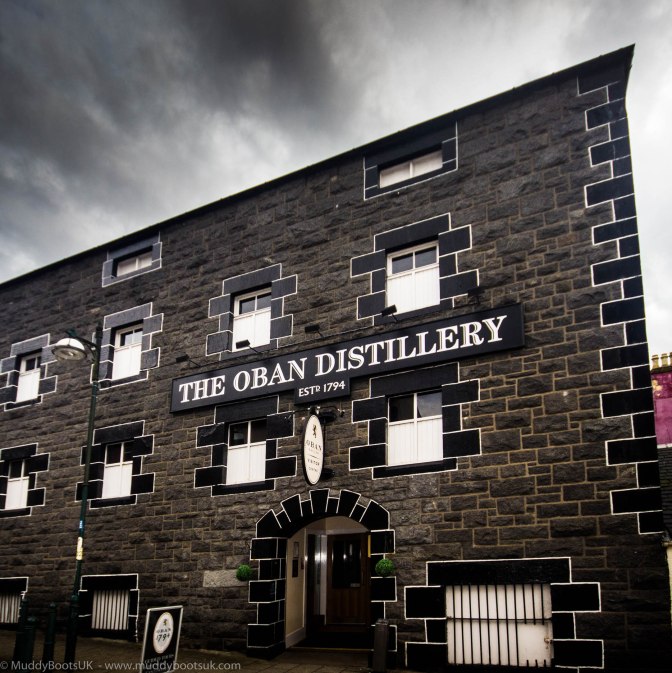
We have visited here previously, although it must be around twenty years ago but I don’t think much had changed with the process and we needed to press on towards Mallaig, so it was just a quick nip into the shop and grab a bottle. We picked up a bottle of Oban “Little Bay” and was ably assisted by a young American guy who had obviously been on the tour and was listening intently to our indecision – thank you sir! Great choice you helped us with. Oban Little Bay is “married in the smallest casks available at the distillery, 200-litre ex-bourbon barrels. This has resulted in a rich whisky with notes of stone fruit, spice and honey” – so there you are! We went to pay and the chap on the till asked if we had been on the tour, we said we hadn’t, but said we were to honest to lie about the tour to get the £5 discount – this must have impressed him, so he have us the discount anyway; stout fellow!
We made our way back to the station car park and stowed the bottle in the boot with the ever expanding collection, jumped back in and fired up the engine and continued our way up to Mallaig. We drove up the coast road heading for Ballachulish and then Fort William, past Glenfinnan viaduct and along the A830 into Mallaig.
We made good progress for the 86 miles, and pulled up at the CalMac ferry terminal on the harbour at Mallaig. As we drove in there were a number of cars waiting for the 18:10 departure to Armadale. As we slowly approached there were two CalMac staff members milling around and they stopped us, checked our names and tickets and said that due to the high winds the ferry may not sail this evening. This put quite a damper on our progress as we just had to sit and see what the captain wanted to do when he docked.
We parked up in the queue of cars, stopped the motor and got out for a wander around Mallaig as we had some time to kill. It was a larger town than I had expected, although this wasn’t my first time here I didn’t really recollect much of it from my previous visit. The fish and chip shop was open and doing a roaring trade, and the Co-Op supermarket was bustling too. After seeing the sights, we made our way back to the harbour and watched the ferry chugging across the Sound of Sleat and lazily making its way back to port. It pulled in, moored up and the traffic and passengers disembarked. We were extremely pleased to see that the crew started loading the waiting traffic, and thus avoiding a 113 mile, and two and a half hour drive to the Skye Bridge. I’m sure there was nothing at all to be worried about and this was just how the CalMac staff like to amuse themselves on a slow day.
The ferry soon pulled out of the harbour and chugged its way across the very choppy waters to Armadale on the southern tip of Skye. This was a different type of car ferry from the larger boats we had been on and was tossing about a fair bit on the water. I can see why they gave a warning about it not possibly sailing. No sooner had I wandered about and then got a seat in the passenger lounge and made myself comfortable we were pulling into Armadale and had to make our way back to the car. We climbed in, started the engine and got ready again for the Le Mans type start and the mad dash up the A851 heading towards Broadford. We were soon back on dry land, and rapidly making our way up the A87 through Skye in the vanishing light. We could make out some of the impressive looking hills as we drove around the head of Loch Ainort, but in the disappearing light we couldn’t make out too much, and I was trying to keep an eye on the road. We passed the Sligachan Hotel, and continued north through Glen Varragill and were were soon dropping down into Portree. We drove through the town and followed the SatNav directions to The Cuillin Hills Hotel.
We found this tucked away in its own grounds to the north of Portree Bay. It was a grand place, and was certainly an upmarket type of establishment. We checked in and the lady on the reception desk was very helpful in establishing times etc, for our revised journey to catch the ferry in Ullapool. We made our way to our room, which was very large and well furnished, and so hot you could prove bread in it. We opened the windows, freshened up and went out into Portree to sample the nightlife…well, more accurately have a couple of beers and get somewhere to eat.
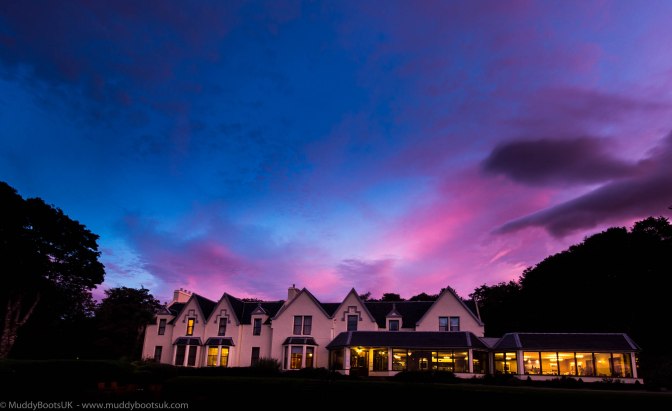
We wandered around Portree with our noses pressed to the glass of several swanky looking eateries, and whilst they had tempting menus, none of them seemed to hit the spot. We went for a drink first to The Merchant bar on Bosville Terrace and took a seat facing the bar. There were a few people in the bar, but it wasn’t crowded by any means and I ordered a couple of pints of Skye Ales lager and a bitter. There was a gut stood at the bar who had a large plastic bag with some flat pack type book shelves in it. It transpired that he had nipped out to collect the shelves from a local shop earlier in the day and had decided to call in for ‘a quick one’ on his way back home. The way he was swaying and staggering suggested that the quick one, had morphed into a long several. We sipped at our drinks whilst making a decision on where to eat – the restaurant adjacent the Merchant Bar looked quite inviting, with a decent menu too. After much discussion we drained our glasses and went back downhill to see what would take our fancy, and as we walked from Wentworth Street, uphill towards Bosville Terrace we took on the stance of the Bisto Kids as we smelled a curry house. We eventually found the Taste of India on the first floor of a row of shops. To date we had been fine dining and also on a seafood odyssey, so the thought of a curry was an excellent change. It must have been the beer that got our taste buds wanting for something spicy. The entrance to India Spice was in the centre of the building, with a staircase leading to the first-floor restaurant. As we walked up the stairs our sense were assaulted with the familiar scents of the spices used in the food. It was mouth-watering. As we entered the restaurant the Maitre’d showed us to a table for two next to the window. The menu was a combination of the standard ‘Indian’ food such as Rogan Josh, Dupiaza etc, despite all the staff being Bangladeshi, and in addition there were several Chef Specials which I had never seen before, and were apparently authentic Bangladeshi cuisine. We went for the usual poppadoms, mains, naan bread and several cold beers. We finished our meals and handed back clean plates, and left reasonably impressed by the food we had just had. We made our way back to the Cuillin Hills Hotel, waddled upstairs to our room and went to bed.
Tuesday 4th October – Day Four – The Skyes the limit?
I woke quite early in the morning, glanced out of the window and the sky looked promising, so, again, I decided to get out with my camera before sunrise. I had tried the previous evening but everything was just wrong about the scene; the lighting was too harsh, the composition etc, etc. There was a glorious sunrise, and I went out down to Portree Harbour to see if I could get anything useful.
I stood outside the hotel, on the lawn in the growing light and looked towards the Cuillins which were wonderfully framed on the horizon. I was initially doubtful about the hotel name, and said the Mrs Muddy Boots that they were a tad ambitious and the name was possibly the result of a marketing focus group, and there would be Cuillin this, Cuillin that and Cuillin t’other on Skye – I was wrong about the hotel name, and could not be more pleased that I was. I drove down to the harbour, parked the car and proceeded to get various shots in and around the harbour. I was surprised to see a large group of Japanese tourists stood on the corner of the harbour with cameras and furiously clicking away in the direction of the sunrise. One enterprising chap had got a hold of a pair of step ladders and was using them as a makeshift tripod. This group slowly dispersed and I wandered around looking for good view points and decent compositions. I ended up at the end of the small pier next to the jetty for the lifeboat. A group of three lads came walking down the harbour and we ended up chatting. They were on a motorbike tour of Skye and had come from West Yorkshire and were just mooching around until they could get breakfast at their hotel. I knew that feeling so I made my way back as I didn’t want to miss my breakfast.
We went down to the dining room and had a wonderful repast over looking Portree Harbour and the majestically distant Cuillin mountains. We loaded the car with our bags and went and checked out, looking forward to the delights of Skye and anticipating our lunch at the Three Chimneys at Colbost.
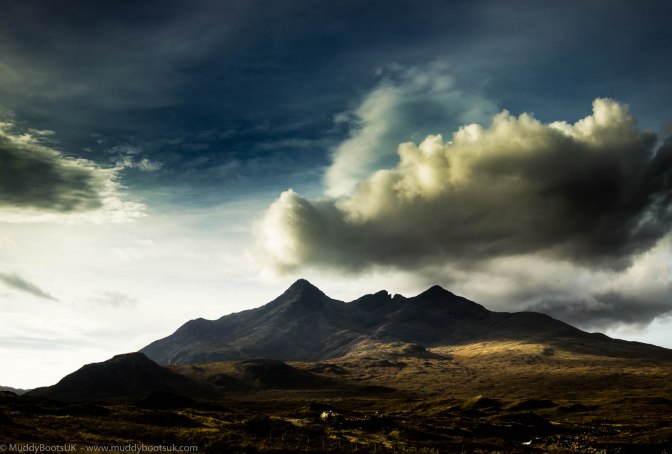
The Cuillins from Sligachan
Our first port of call this morning was to the Talisker distillery at Carbost and overlooking Loch Harport. It was an easy drive to get their, leave Portree on the main road south, get to the Sligachan Hotel and turn right along Glen Drynoch.
After a short distance take a left turn down a steep hill on a single track road and follow this until you get to the distillery itself. As we arrived the car park had a scattering of vehicles, so we got out and headed towards the shop, just before going in I wanted to grab a shot of the outside of the distillery and made the mistake of hanging around for too long next to a coachload of foreign visitors. By the time I had got my photos, the crowd from the coach had a head start on me and the scene inside the shop and visitor centre was chaotic and added a considerable delay to our wee dram sample and purchase routine.
The distillery was founded in 1830 by Hugh and Kenneth MacAskill, and built in 1831 at Carbost after a number of false starts on other sites when they acquired the lease of Talisker House from the MacLeod of MacLeod. The distillery was rebuilt 1880–87 and extended in 1900. When a new lease for the distillery was negotiated with the chief of Clan MacLeod in 1892 the annual payment was to be £23.12s and a ten-gallon cask of best-quality Talisker. It was rebuilt in 1960 after a stillhouse fire completely destroyed the distillery. The distillery operates five stills; two wash stills and three spirit stills. All the stills use worm tubs (condensing coils) rather than a modern condenser, which are believed to give the whisky a “fuller” flavour (itself an indication of higher sugar content). During this early period, the whisky was produced using a triple distilling method, but changed to the more conventional double distilling in 1928. Talisker was acquired by Distillers Company in 1925 and is now part of Diageo. After the 1960 fire, five exact replicas of the original stills were constructed to preserve the original Talisker flavour. In 1972 the stills were converted to steam heating and the maltings floor was demolished.
Talisker’s water comes from springs directly above the distillery via a network of pipes and wells. The malted barley used in production comes from Muir of Ord. Talisker has an unusual feature—swan neck lye pipes. A loop in the pipes takes the vapour from the stills to the worm tubs so some of the alcohol already condenses before it reaches the cooler. It then runs back in to the stills and is distilled again. Talisker now has an annual output of three and a half million litres of spirit and was the favourite whisky of writers Robert Louis Stevenson and HV Morton. In his poem “The Scotsman’s Return From Abroad”, Stevenson mentioned “The king o’ drinks, as I conceive it, Talisker, Islay, or Glenlivet.”
I managed to corral one of the staff into offering a couple of drams as a taster, we both went for the same sample which is as 2001 vintage of Talisker’s Distillers Edition, which is double matured, with the finish taking place in Amoroso casks, similar in style to sweet oloroso sherry. This adds sweetness and extra fruitiness to the smoke, and I can safely say that there is a lingering sweetness on the palate well after the initial smokiness has dissipated. It is a great easy drinking dram.
After leaving Talisker, we stowed our bottle in the boot of the car with all the others, and then proceeded to drive up to Colbost, a distance of 24 miles, for our lunch date at the Three Chimneys. We got there sooner than anticipated. Colbost is on the north west tip of Skye and on the road to nowhere and the Atlantic. It is approached down a single track tarmac road with many passing places, and it is not the sort of place you can get to in a hurry. It was fortunate we got there early as we had a 140 mile drive from here to get to our redirected ferry from Ullapool. Needless to say, the lunch was excellent, I’m not going to even try to describe it here as others have done so many times previously on Tripadvisor and in the National broadsheets. What I will say is that I have never been to a restaurant before where they serve different butters to accompany different breads. I felt I was clock watching all the time as I knew we had to be away for 1:30pm to get to Ullapool for the check in time.
We had three courses each and I finished with a wonderful chocolate pudding whilst Mrs Muddy Boots had a selection of cheeses – she doesn’t do sweet stuff. We paid the bill and it came to £135 for the two of us, including a good bottle of wine and a couple of bottles of mineral water which wasn’t too bad at all considering the reputation of the place. I did read after I had booked it that it was listed in the top 50 world restaurants. We paid the bill and reluctantly, but speedily, left the restaurant behind, and instead of slowly meandering up to Uig we were on a race meeting to Ullapool – thanks CalMac, you’re just great!
We quickly made our way down the Isle of Skye, over the bridge to Kyle of Lochalsh, up the A890 along Glen Carron, the picking up the A832 through Wester Ross. The stretch through Glen Carron was spectacular. There were some great straight parts along this high level and isolated road and we did make up a lot of time. I did keep an eye on the ETA of the Sat Nav and the time started to tumble as we progressed. We then jumped on the A835 which climbed all the way up to Loch Glascarnoch with its impressive looking dam at one end above the Aultguish Inn, and we continued to rapidly follow a Land Rover Discovery alongside Loch Broom whose driver clearly knew the road. We ended up in a convoy of traffic headed by a large truck who could maintain a fair turn of speed too, and all of us pulled into the ferry terminal at Ullapool with five minutes to spare and to rest a while to let the adrenalin rush subside. On getting in the car at the restaurant I hadn’t really expected to make it here, but we had. The boat was already docked, and a long line of cars and trucks were waiting silently to board.
We had been handed our boarding passes as we screeched to halt on the car park, and we now clung onto these ready to drive onto the boat. We hadn’t been parked for very before the the vehicles started to fire up their engines and make their way across Shore Street and onto the loading ramp. We were soon on board and parked up. We climbed out of the car, locked it and went up to the passenger lounge.
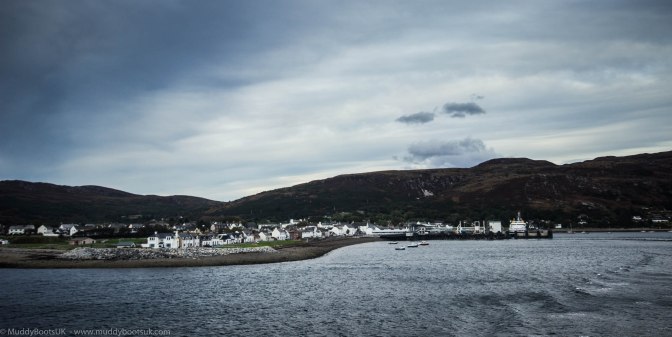
The boat pulled away from the jetty and made its way along Loch Broom and headed in a north westerly direction towards the Outer Hebrides. The mainland gradually disappeared and we headed towards the Isle of Lewis and watched a wonderful sunset behind the island.
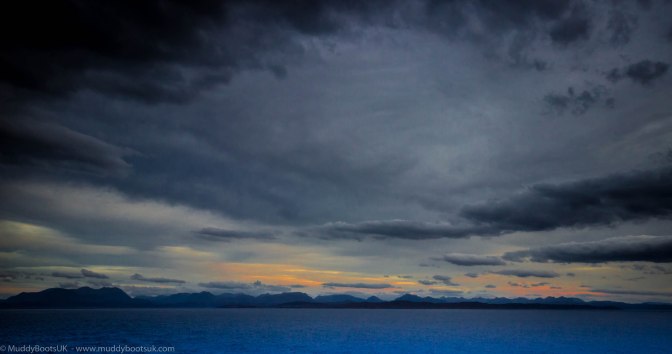
The crossing was uneventful, and the sea was flat all the way across. Gradually the looming darkness was replaced by the twinkling lights that ran along the houses and shops on the shoreline of Lewis. When we pulled into Stornoway it was dark, although the port was well lit.
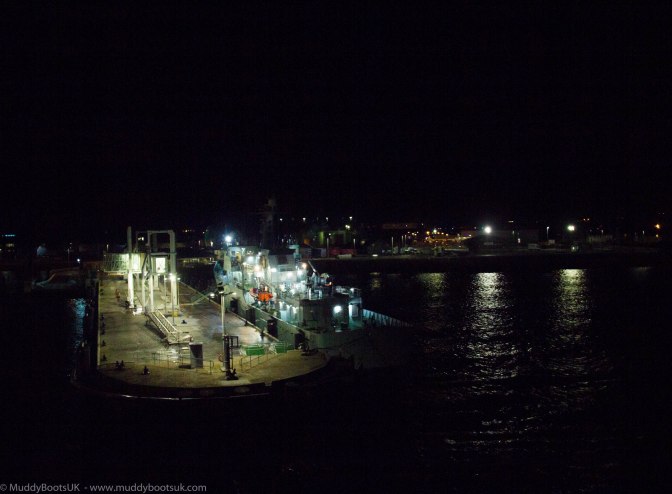
The PA system asked us to return to our cars, and we were soon making our way up the metal ramp to get back onto dry land. The exit strategy for leaving the port seemed to be based on the 70’s childrens cartoon Wacky Races. Cars were zooming down various side streets in the centre of Stornoway, around roundabouts, through traffic lights and all seem to converge in a long line on the A859 travelling south. The convoy of vehicles we were in were making very good progress, and must have been lead by someone familiar with the road; most likely a local chap. I was pleased to be following, albeit at a small distance, a car in front and I could use his tail lights (and the SatNav display) to show any curves in the road. Every now and again when we hit a straight piece of road, a local driver would thrash past in the dark. I was doing around 70mph, and these guys were really blasting past – there were no street lights, and it was pitch black. I decided not to even try and keep up; we were headed south to Tarbert on Harris and I wanted to make sure we got there in one piece. The roads were well maintained and had a number of sweeping bends around rocky headlands or lochs. It took about 50 minutes to drive from Stornoway to Lewis, and as it was all in darkness I couldn’t say much about it.
We pulled into the car park of the Harris Hotel at just before nine o’clock. We went and checked in at reception, and then went straight to the bar and dining room. We had telephoned ahead to let the hotel know about our change in ferries, and they said they would keep the kitchen open so we could get some hot food. We got ourselves a couple of beers to drink whilst we perused the menu. We were more concerned about keeping the kitchen staff hanging around, so we went for something quick. We both had Cullen Skink, followed by the Aberdeen Angus Burger and fries. The food was good and plentiful, and beer cold and refreshing. It had been a long day, so we had a whisky nightcap and Mrs Muddy Boots went back to our room whilst I brought all our cases in and lugged them upstairs so she could have something clean to wear the next morning. I’m not that fussy; I change my socks once a week whether they need it or not! We fell asleep to the sound of a small stream trickling past our window. During the night I awoke and looked out of the window to see a huge blanket of stars covering the clear sky. It did cross my mind to get in the car, (well, to get dressed first) and drive up to Callanish Stone Circle on Lewis and get some night photos, but the lure of a soft bed dragged me back. What a Slacker!
Wednesday 5th October – Day Five – Tweed wearing, gin swillers, what-ho?
We went down to breakfast in the rather grand formal dining room, and found ourselves crammed into a small off shoot at the rear with several other guests who were all whispering to avoid each other’s morning conversations being overheard. It was like the management were trying to hide us all out of sight in case we frightened new visitors. I chose the full Scottish breakfast, which is very much like a full English but with the addition of some haggis and usually an oatcake so hard you could nail it to the sole of your boot for a temporary repair. Mrs Muddy Boots went for the smoked fish with poached egg; she had the eggs but left the fish and she said it was slimy. I tried it, and it seemed fine and very smoky – but then I have never been a fussy eater. We discussed what we would do today, and decided that we should get ready and check out. After checking out we drove the very short distance to the first delight of the day, and the primary reason for coming up here. The Harris Tweed shop – on Harris! A shrine to the art of the weaving crofters.
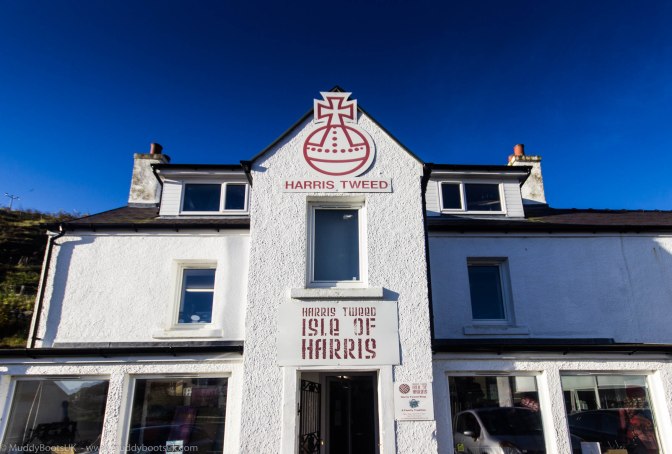
We parked outside the Harris Tweed shop near the ferry in the centre of Tarbert. There are two buildings here, one is a large converted house and the other is a more modern type of ‘shed’ structure. We went into the house first, and it turned out that we had wandered into the Warehouse for the rolls of Harris Tweed.
Thre was a distinct ‘woollen fabric’ smell to the rooms. The rolls of cloth and the variety of colours available was huge. There was a young guy working in the shop called Brendan, who discussed the protection that Harris Tweed is given and the strict rules governing its weaving. For the uninitiated, The Harris Tweed Authority is the legally appointed governing body responsible for upholding the integrity of Harris Tweed in accordance with the Harris Tweed Act of 1993. They are involved in instigating litigation, issuing of the Orb Stamp trademark (see photo above), inspection of mills and weavers sheds, promotion of the industry and safeguarding Harris Tweed on the behalf of the islanders of the Outer Hebrides.
We had a good look around but Mrs Muddy Boots didn’t take up my offer of buying 5 yards of cloth and getting my tailor to make a jacket up for her. We thanked Brendan for his time and crossed the street to the other shop. The other shop sells all manner of Harris Tweed products, from hats, coats and gloves to bags, scarves and slippers. In addition to the Harris Tweed, there were other Hebridean related goods. Mrs MB came away with a very nice pair of gloves, along with assorted gifts for relatives. We stowed these in the back of the car and then walked down to the Harris Distillery.
The distillery is almost brand new. It opened in 2015, and is unable to sell it’s whisky until 2018, that year being the age its cask reach the minimum three year period for a spirit to be legally recognised as whisky. In order to provide cash flow, the distillery is producing its own gin, and joins the growing ranks of artisan gin now available in Britain. We wandered around the very new, and very modern looking shop/visitor centre which was also a testament to the modern miracles of interior design and good marketing. We ended up chatting to the South African lady who was operating the shop and she said they had a small problem with the gin. They estimated selling 20,000 bottles to give enough cash to keep the distillery going in it’s first year, however they had now sold 60,000 and couldn’t get the distinctive glass bottles produced quickly enough to keep up with demand. Some problem eh?, at £30 a bottle – as our American friends say “You do the math”
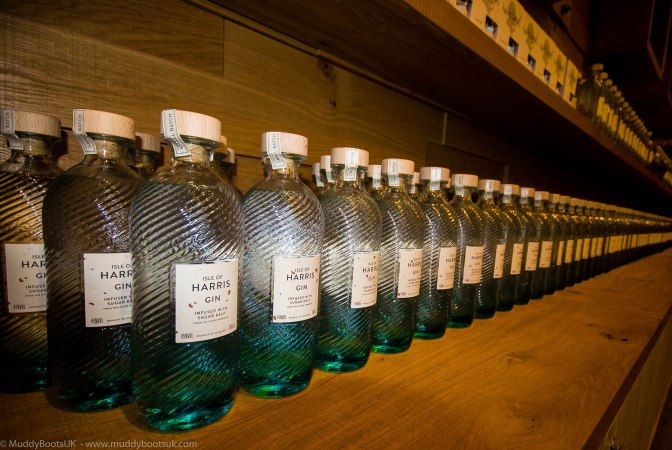
We came away with a couple of bottles to try, and they joined the rest of the stock in the boot of the car. Our next stop was south and over the hill that sits adjacent to Tarbert. We headed south on the A859 towards Seilebost. About a mile before Seilebost we took a right turn at a bus shelter to take the single track tarmac road to Luskentyre. We headed along here until we got to the end of the road, and parked the car next to a small block of public toilets. We got out of the car, and went through the small metal gate leading to the beach. After a short 5 minute walk through some small sand dunes we had got to the majestic Luskentyre beach. Now think of a tropical beach in the Caribbean, but without palm trees and with a sea temperature a notch above freezing, then that is Luskentyre. It is a beautiful place, and we got the right weather for it too, although I would wager it takes on a different hue with slate grey skies, hurricane winds and horizontal rain.
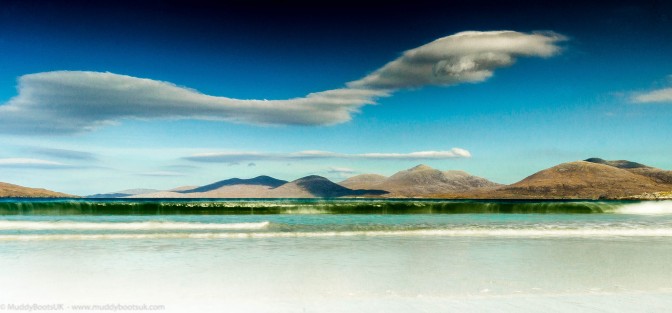
We walked along the beach for a while and took in the remote beauty of it. There were a number of people there to prove its popularity. We walked back the way we came and as we passed back through the dunes we were met with a retired lady who had a rolled up beach towel under her arm. “Going for a dip?” I enquired, and she replied with a “Sure am! I’m here so I may as well” which is an attitude I quite like; don’t stand on ceremony, just bloody well do it.
We knocked the sand off our boots and climbed back into the car, and set off back on the road to Tarbert. Along the way we passed a sign for Harris Tweed & Knitwear and this being in Mrs MB’s range of interests, we took a right turn and drove down to Grosebay. We parked up and entered the small shop, and had a look around. Mrs MB seemed to entertain herself by picking up pristine garments from shelves, unfolding them, scrunching a sleeve up, letting it go, saying “Hmmmmmm” sotto-voce and then placing it, in disarray, back on the shelf it came from. She certainly knows how to create work for shop assistants. It seems that this method is favoured by many women when shopping for clothes.
We didn’t purchase anything from this place despite unravelling their well manicured displays, although I did feel quite embarrassed about that and felt that we ought to in lieu of the general dishevelment that Mrs MB had left the shop in.
We turned the car around, made our way back to Tarbert and crossed up onto Lewis and headed towards Callanish to visit the famous standing stones. Lewis and Harris are actually one island. There is a boundary between the two, but no border guards patrolling as I could see. We continued north on the main road to Stornoway, and then took a left turn and picked up the A858 toward Callanish. This road was excellent and had some real long straights in it, which were great for overtaking slower traffic such as trucks and tractors. We soon arrived at the car park to the visitor centre for the standing stones. We walked up through a small wooden gate in a gap in the drystone wall and the stones were there. We had a wander and I tried taking some photos, but every angle had someone in shot so I just gave up. I should have gone very early in the morning when the thought crossed my mind about the clear sky when back at the hotel. We retired back to the cafe on the visitor centre, and ordered fish and chips and decided to sit outside in the warm sunshine and eat. There was a small wooden hatch in the wall of the cafe, and the food was dispensed from here, although we did have to walk all the way around the building in the first place to get to these tables. We ate our lunch overlooking Loch Rog looking to the south west of the visitor centre. After clearing our plates we decided we should head back down to Tarbert to get the ferry back over The Little Minch to Uig on Skye.
We arrived back at the ferry terminal at Tarbert and awaited the boat. We were quite early despite a large number of other cars waiting. We locked the vehicle and walked back to the distillery, and entered the ‘canteen’ and ordered a couple of gin and tonics prior to our boat ride. They were served with pink grapefruit and a local tonic water – and very good they were too.
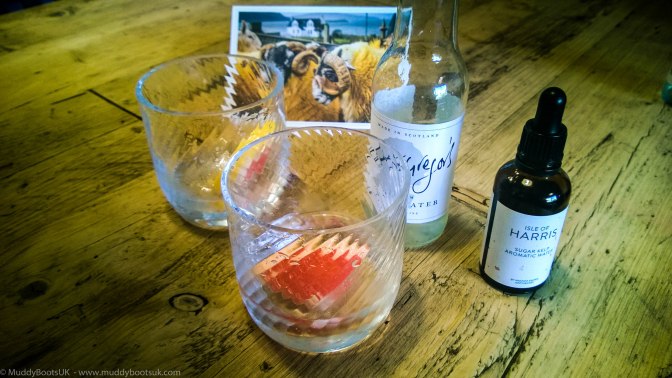
Isle of Harris gin with Walt Gregor’s tonic water. The small bottle is Sugar Kelp Aromatic Water to add to the gin.
We were by now used to the ferry routine, but it still hadn’t lost its spell of making you think you were ‘really’ going somewhere. The boat was soon loaded, and did an about turn to head across the Little Minch towards Uig on Skye. I sat out on the observation deck, taking in the late afternoon sunshine, and finding the sea breeze very refreshing. After a couple of hours we approached Uig, and its setting on Skye looked very impressive in the setting sun. We entered Uig Bay and the boat moored up at the vehicle jetty. We exited with the usual squeal of tyres and clouds of exhaust smoke. As we drove out of Uig, we rounded the head of Uig Bay and the road climbed high up above the town and gave an amazing, wide clear view of the bay. In fact, a coach load of people had pulled over in front of us and they were all getting out and clicking their cameras to record the scene.
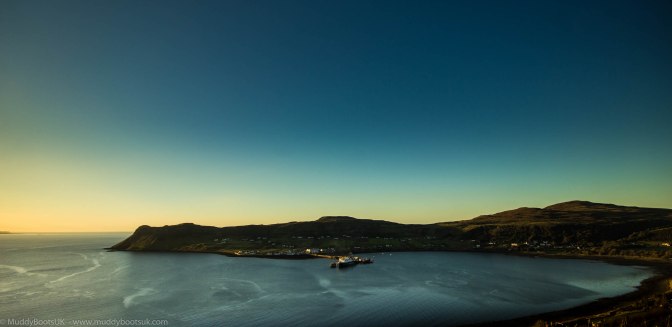
We quickly made our way south, back across the island and headed towards Sconser, which was south of Sligachan. We drove straight past the entrance for Sconser Lodge and had undertake a U-turn a mile or so up the road and come back down the hill. We turned right off the main road and approached the hotel down the gravel driveway to a grand neo-Gothic late Victorian Shooting Lodge built by the MacDonalds, overlooking Loch Sligachan. The sun was setting as we arrived. We entered the Hotel and was greeted warmly by Norrie, the receptionist, waiter, Maitre’d and everything else that a hotel needs. Norrie is an ex-semi pro footballer, with a keen wit and an engaging charm. We checked in and I went back out to the car and brought our bags up to our room. We had booked a table for dinner at Sconser Lodge, and after freshening up went down to the dining room.
We were greeted again by Norrie, and shown to our table. The dining room was very subtly lit with electric lights and there were candles on every table. There was gentle Celtic styled background music playing and the quite clink of glasses and cutlery with low murmurs of conversation. The menu was simple and good. The chef is Craig, who is the owner of this gem of a place. We had a nice bottle of red, a Rioja I think, to go with the steak we ordered. The steak was cooked exactly to my liking, and was accompanied by a simple green salad and hand cut chips. It was delicious! I finished with a chocolate pudding, and Mrs MB finished with a separate spoon so she could help herself to my pudding. We finished the last of the wine and Mrs MB decided she wanted to go up to bed and watch TV for a while. I had other plans; I grabbed my camera and tripod and went outside to see if I could get any decent shots of the sky or the hotel.
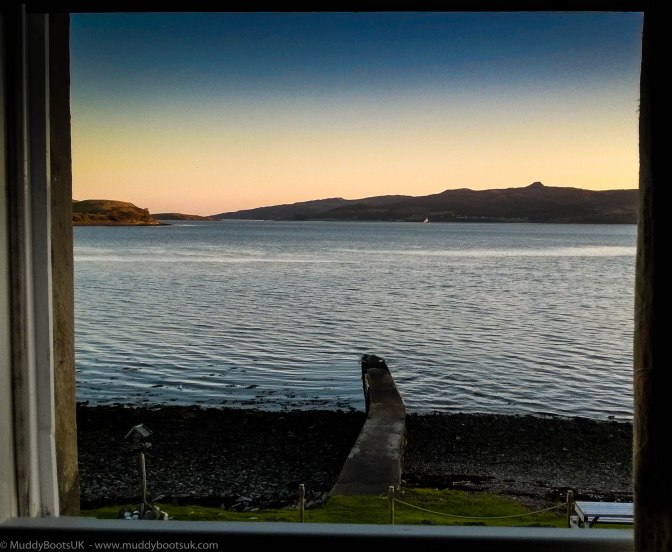
The view from the window of our bedroom at Sconser Lodge
The sky was absolutely clear and a myriad of flickering pinpricks of light were shining in the blackness above me. I gingerly walked down the concrete pier facing the hotel to try and get some shots of the front of the building, with the sky twinkling above. Unfortunately, there were external spotlights on and these over exposed the shots I tried. As I was stood in the darkness looking at the hotel front, I noticed two people leave the front of the hotel and set up a tripod on the small lawn adjacent to the pier. Obviously other hotel guests. After a couple of minutes they had moved away from the front and had disappeared. I decided that I would get into the car and drive to Sligachan Bridge to see if there was anything worth doing there. I got into the car, reversed out of the parking space and headed back up the gravel driveway. As I approached the gateposts two people were illuminated in the headlights, so I wound the window down and asked if they wanted to jump in and come up to Sligachan Bridge to do some night-time photography. The two people were Travis and Shannon, from Washington State and they were on a road trip of Scotland. Shannon was the photographer and Travis was relegated to photographers assistant, which usually meant carrying her kit around, especially the sticks (tripod) – in fact he became known as ‘stick boy’. We drove up to Sligachan, parked on the small car park before the bridge and made our way out to the old bridge. The sky was incredibly clear, and the Milky Way was clearly visible.
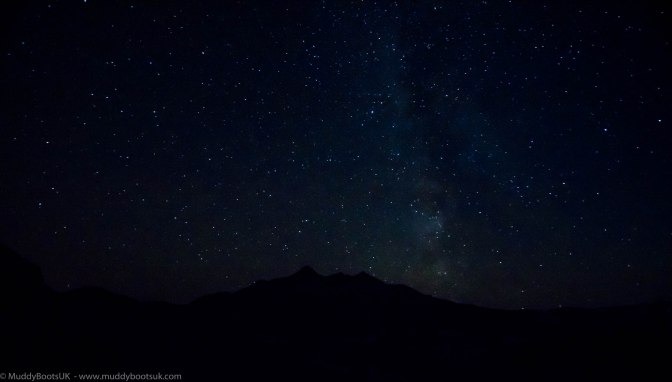
Shannon had the foresight to bring a head torch whilst Travis and myself stumbled around in the dark slipping on wet rocks and standing in muddy pools. We tried various vantage points and various angles to take some longer exposure images, but it is difficult to really see what you have captured on the small LCD screen on a DSLR. You need to wait until you get back to a PC to appreciate what you have got, or in my case what I didn’t get.
At around 11pm we made our way back to Sconser. We parked the car and the hotel was in complete darkness. I got my key out, and to my surprise there was only the room key on the metal ring and no front door key. Travis came to rescue as he said there were two keys on his key ring, so he tried the door and the keys didn’t fit. We were in trouble! I didn’t really feel like sleeping in the car, and there was hardly any room due to the whisky onboard. Fortunately, Mrs MB had left our room windows open so I managed to get her attention and she came down to the front of the hotel and opened the doors to let us in. A close call indeed!
Thursday 6th October – Day Six – The Long Drive Back
We came down for breakfast early and had a wonderful seat by the window and watched the sunrise over the Loch and the ferry and various fast moving RIB’s shuttling to and fro on the water. After finishing a hearty breakfast and we were going back up to our room to pack, Travis and Shannon came down. We exchanged cards and said our goodbyes and we went to check out.
After loading the car up we made our way down to Glen Brittle to take a walk to the Fairy Pools. These are a series of waterfalls, and turquoise/azure pools in the river Allt Coir’ a’ Tairneilear which runs down from the peak of Bruach na Frithe, Sgurr na Bhairnich and Sgurr an Fheadain which form the main peaks of the Cuillins. We headed along the road towards the Talisker distillery, and turned left some distance before. We continued along this narrow tarmac road until we reached a car park on our right. The car park was very busy, but we managed to find a space. Opposite the car park was a path leading to the falls and looking down the path one could see a long line of visitors. As we were here we went for a look. It was absolutely packed with visitors and difficult to get a ‘clean’ shot. I did try from various angles, but the sun was directly in front of the lens and was over exposing the image so you couldn’t make any details out. After twenty minutes or so of trying different locations i decided that I was wasting my time, and I don’t think my heart was really in it due to the numbers of people present. We started making our way back along the mile and half long path to the car park when I noticed two familiar looking figures walking towards me – it was Shannon and Stick Boy. At breakfast they did say they would be visiting the Fairy Pools, but I didn’t expect to bump into them. We had a brief chat about the conditions and parted again. When we got back to the car park it was less busy than when we arrived, so I made a note to myself that on my next visit I should come at dusk and hopefully it would be quiet.
We got back in the car, pressed ‘Home’ on the Sat Nav and set off back across Skye and headed towards the Kyle of Lochalsh and the Skye Bridge. We stopped in Portree to fill the car up with fuel, and had to queue for 20 minutes which I found unusual, then after I had paid the exit from the petrol station was then blocked by a large truck filling with diesel at the high capacity pump next to the road. Chaos ensued!
The roads on Skye are great and we made rapid progress south towards Kyleakin. We crossed the impressive single span concrete bridge and expected to head towards Fort William, our Satnav though had a different plan. The SatNav has the facility to get updated traffic information and will automatically re-route if there is a time saving due to traffic accidents or roadworks. We got as far as Spean Bridge and the device then took us up the A86 alongside Loch Laggan, and was headed for the A9 southbound. Fortunately it took us past the Dalwhinnie distillery, which was not on our planned itinerary, so we just had to call in (and this would make up for missing the Ben Nevis distillery at Fort William)
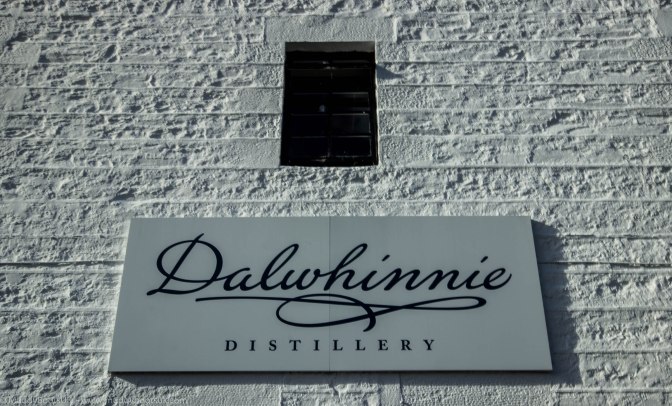
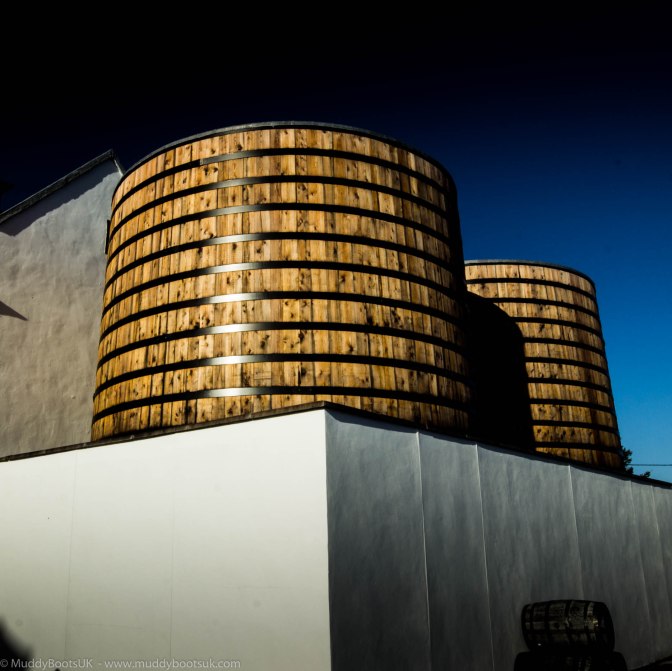
We entered the shop and visitor centre and it was packed solid. It would seem that we arrived just after a couple of coaches. We didn’t have time to ponder or even have a wee dram to test, so we just grabbed a bottle of Winters Gold, paid and departed. Apparently, it’s made only with spirit that has been distilled between October and March, and interestingly enough, they suggest that you try serving this expression frozen! It is “An assertive, spicy, honeyed Dalwhinnie with enough sweetness and character to be served straight from the freezer (as intended).” It is a bit more-ish though.
We got back into the car, and picked up the A9 which is a ‘proper’ main arterial road passing up the east coast of Scotland. Again, we were making good steady progress until just before Blair Atholl we hit a large retail outlet called “The House of Bruar”. I know the name from the many parcels that I have taken to the Post Office in order for Mrs MB to return her internet shopping. In fact I think the Royal Mail would cease trading if she stopped returning items bought late at night after a glass or two of wine. We pulled into the large car park and got out, I was dragged into the Women’s Countrywear department and made a series of low grunts as I was expected to voice enthusiastic opinions on different coats, jackets and hats which she tried on. What I have now started to do is to take her into the power tools section of DIY stores and ask her opinions on cordless drills, saws and screwdrivers. She always replies with a “How am I am supposed to know which is best?” to which I reply “Just wanted your opinion as I am supposed to know about handbags and shoes”. After grabbing some food and reeling with shock after parting with 200 quid for some woollen tartan blankets, we got back into the car. We then set off back down the A9/M9, past Stirling and Cumbernauld and picked up the M74 outside of Glasgow. We then continued south for a few hours until we got home late in the evening. It was approximately 450 miles from Glen Brittle to Home.
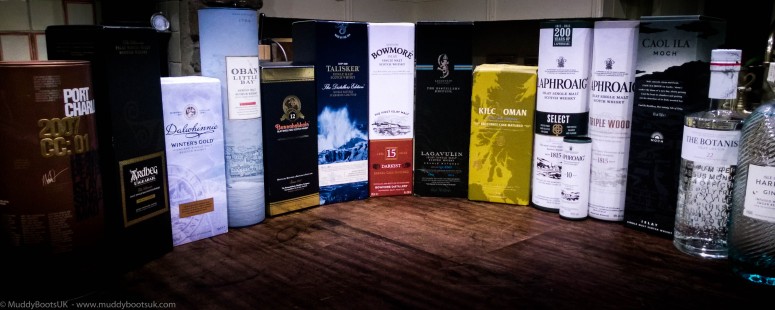
I did miss out on quite a few things to see on Skye, however I will be back up there quite soon. Although it is a long drive, it isn’t difficult to get to and a bit more pre-planning would help with the natural wonders that are awaiting for the revisit.
This has been quite a lengthy blog post compared to the usual stuff, so I’ll sign off now and get back to the normal stuff as soon as possible.
Cheers,
MB.
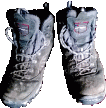















































































Scotland is always worth the traveling, even for a few days. And you’re lucky as you had only a few hundred miles to go.
Which reminds me of one week-end when my late husband and I had the idea of going to Switzerland just for having breakfast, so we got up in the middle of the night and went by car just a few hundred miles – and right behind the border we had coffee and some scones in a café. But, unlike you, we had no clue what to do once arrived there, so by accident we found an archaeological place to visit and walked through Roman ruins. It was great fun to to something unusual for the week-end….
But coming back to your article: I really love your pictures, and guess what? I envy you a little bit for having seen the Northern Lights. I so wish to have the same opportunity. Awesome pictures – great post.
cheers
Ulrike
LikeLike
Thanks for stopping by Ulrike; You’re lucky in being so close to Switzerland with it’s very impressive scenery. Sometimes, the best memories are made from the less planned trips.
Thank you for the kind comment on the photos – I just press the shutter!
MB.
LikeLike
Oh, thank you very much. Being close to Switzerland does not mean that you’re seeing the very high mountains soon. It took us nearly 8 hours to get to the Lake Geneva – but we planned our holidays in that region early in advance. We spent our summer holidays 2009 there and I had the chance to see the Montblanc –
LikeLike